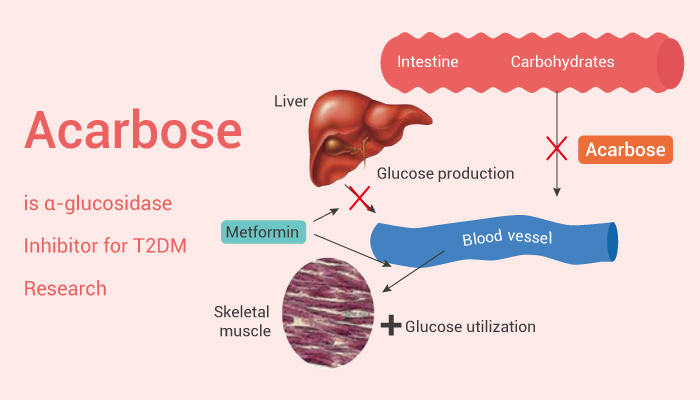Glucosidases are glycoside hydrolase enzymes, including α-glucosidase and β-glucosidase. Among them, α-glucosidase is a glucosidase located in the brush border of the small intestine that acts upon α(1→4) bonds. Importantly, α-Glucosidase inhibitor is a new type of antidiabetics. By reducing the postprandial blood sugar concentration, it can effectively control the blood sugar levels, thereby reducing the occurrence of diabetic complications.
Acarbose (BAY g 5421), an antihyperglycemic agent, is an orally active alpha-glucosidase inhibitor.

Acarbose can potentiate the hypoglycemic effects of sulfonylureas or insulin. Thus, Acarbose has the potential for noninsulin-dependent diabetes mellitus research. It controls postprandial hyperglycemia by inhibiting α-glucosidase activity in the small intestine. Besides, Acarbose delays the digestion of complex carbohydrates and disaccharides to absorbable monosaccharides by reversibly inhibiting α-glucosidases within the intestinal brush border. Acarbose also reduces myocardial infarct size in animals by opening mitochondrial KATP channels. An in vivo study in rabbits shows that Acarbose can improve atherosclerosis by decreasing levels of aortic sudanophilia, plasma cholesterol, and plasma LDL. In addition, Acarbose can pleiotropically inhibit rabbit atherosclerosis by reducing inflammation, senescence, and VSMCs proliferation/migration via upregulating AMPK signals.
Moreover, Acarbose could promote the proliferation of islet β-cells and inhibit PDX-1 methylation in islet β cells from spontaneous type 2 diabetic db/db mice. In summary, Acarbose may improve glucose metabolism in db/db mice. Furthermore, Acarbose maintains β-cell identity by preventing proliferation through the regulation of Ngn3, FoxO1 and PDX-1.
References:
[1] Kuei-Chuan Chan, et al. Sci Rep. 2016 Dec 7:6:38642.
[2] Diyi Zhou, et al. Mol Med Rep. 2021 Jan;23(1):72.